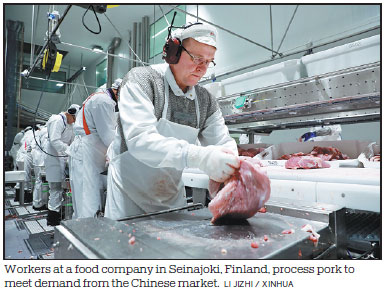Swine fever set to determine global price trends
In the Year of the Pig, domestic pork sector may see imports rise
China is entering the Year of the Pig on an apt note - its huge pork industry is sending ripples across the global commodities' chain.
Traders, analysts, farmers and other stakeholders are closely monitoring how China is managing African swine fever cases. China is the world's biggest pork producer and consumer, and the impact on its pork supply and demand will determine price trends in the global meat and oilseeds trade.
According to analysts interviewed by China Daily, the price of soybeans - the main ingredient in livestock feed - may soften owing to slower demand as China culls thousands of pigs to bring the disease under control.
International prices, however, are expected to go up as China imports pork to fill the potential shortfall in domestic supply.
"It's possible that that demand for animal feed would decline," encouraging China to import more pork, said Caroline Bain, chief commodities economist of the London-based research firm Capital Economics.
"With China having the world's largest hog herd, the impact of the fever is significant from a global perspective," Charles Clack, commodity analyst at the Amsterdam-based Rabobank, told China Daily.
China has 500 million pigs, accounting for about half of the global swine population, according to the United Nations Food and Agriculture Organization.
"The outbreak could see a significant reduction in (China's) pork production, resulting in less demand for soymeal," said Chong Hoe Leong, commodity analyst at the Kuala Lumpur-based Public Investment Bank.
According to data from the US Department of Agriculture, China buys more than half of the over 150,000 tons of soybeans traded each year.
The department forecasts that China's soybean imports will slide to 90 million metric tons in 2019, from the previous year's 94.12 million tons. The department cited the outbreak as one of the factors that will dent China's demand for soybeans.
It also cited the fever as one of the factors that will impact the global pork trade. It expects pork exports to rise by 3 percent, thanks mainly to higher demand from China.
"Demand for imported pork in China is expected to increase in 2019 as end-users react to lower global pork prices and market disruptions and spot shortages caused by the fever," the USDA said in its latest report on world livestock and poultry trade.
The USDA sees China importing 1.88 million tons of pork in 2019, up 7 percent from last year. This also accounts for about 20 percent of the more than 8 million tons of pork that will be traded in the global market this year.
African swine fever is one of the most devastating animal diseases and was first discovered in Kenya in 1921. The FAO said the virus can spread through direct or indirect contact, can survive for long periods in very cold and extremely hot weather, and can even be found in processed pork products.
While the virus won't affect humans, it is highly contagious and deadly to pigs. What makes it difficult to control is the fact that there's no vaccine that can cure the disease, according to Howard Wong Kai-hay, director for professional development at the College of Veterinary Medicine and Life Sciences of City University of Hong Kong.
The first ASF case in China was reported in Shenyang, in the northeastern province of Liaoning, on Aug 1. Several outbreaks in over 20 provinces have been reported since then. The latest incident was reported on Jan 2, with over 4,000 pigs confirmed infected on a farm at the northeast province of Heilongjiang.
It's not yet clear how the fever came into China, but agricultural officials have repeatedly assured that the situation is under control. Yu Kangzhen, vice-minister of agriculture and rural affairs, said over 600,000 pigs have been culled across the country.
"There is a high degree of optimism in the US pork sector that US producers will benefit from China's increased pork imports, whether directly or indirectly," Will Sawyer, protein economist at Colorado-based agricultural lender CoBank, told China Daily.
prime@chinadailyapac.com

(China Daily 01/08/2019 page3)


















